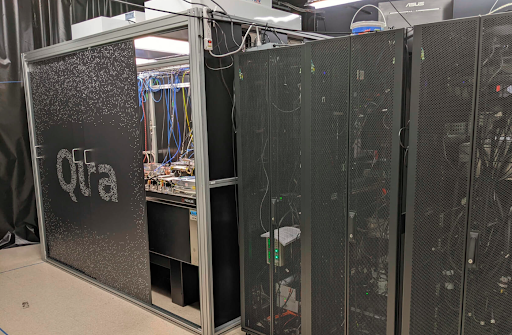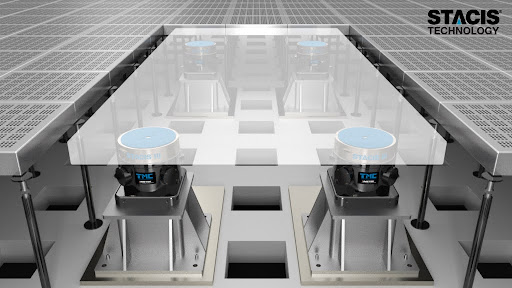Vibration isolation is a challenge in many areas. One of these is quantum computing, on which much of the modern world depends - from computers and mobile phones to jumbo jets. How do quantum computers work and why is it important to address vibration isolation in them? These and other topics were the focus of TMC's interview with Brian Keith, an applications engineer at TMC.
Please introduce yourself to our readers.
My name is Brian Keith and I am an application engineer at TMC. I have a PhD in physics from Clark University, where I worked in the new magnetic materials group. As part of my studies, I created quantum antiferromagnets and tested their magnetic properties to aid in the search for room-temperature superconductivity, one of the holy grails of physics. After graduate school, I worked in cryogenics for ten years, and for the last two years I have worked at TMC.
What is the basic idea of quantum mechanics that quantum computers use?
Quantum computers use quantum mechanics - an extremely successful fundamental theory of physics - to describe the behavior of very small objects at the level of atoms and smaller particles. According to this theory, small objects are not made up of solid particles (such as billiard balls) but are essentially waves. When we look at an electron, for example, it is more accurate to think of it as spread out over a small area rather than having a specific position.
So small objects have a range of momentum, not a defined wave-shaped momentum. This is true until you measure it. When you measure a quantum object or interact with it, the object randomly chooses a particular state and behaves more like a billiard ball or particle. Until it is measured, it is in a superposition of its possible states. All we know before measurement is the probability that the particle is in one state or another, which is a really strange idea.
Why should we believe these strange ideas?
Well, 25% of the world's GDP depends on technologies based on exploiting the strange ideas of quantum mechanics. Without quantum mechanics we wouldn't have computers, mobile phones, jumbo jets etc.
How can we combine quantum mechanics and computers?
In conventional computers, a bit can only be in one state at any given time, either 0 or 1. If you had two bits, they could read 00, 01, 10 or 11. That's four different states; each of them can represent a number, say 0, 1, 2, and 3. If you want to do a calculation, for example, to subtract a number, then the computer can only ever do it for one of these states, so it would do the calculation four times.
Quantum computers, however, consist of quantum mechanical bits, called qubits, which also have two states, 0 and 1, but exist in a superposition of these states. So if you have two qubits, they exist in a superposition of states 00, 01, 10 and 11. When you do the same calculation for a qubit and multiply the number, you only have to do the calculation once, not four times.
If you add a third qubit, you can represent the eight states with one superposition. If you have 20 qubits, you can represent a million states. If you have 300 qubits, you can represent more states than particles in the observable universe.
Why is vibration isolation important for quantum computers?
Quantum computers can be very powerful, but they are also very picky. Qubits are in a superposition of states until the outside world acts on them. For example, the interaction from the environment can be a magnetic field generated by an elevator near the quantum computer or a light beam, a random temperature fluctuation in a room, or a floor vibration. The energy transmitted by any of these sources can easily cause the qubits to collapse, turning their wave nature into more of a particle nature.
Once qubits become particles, they are no longer in a superposition of states and become essentially just bits as in conventional computers. This problem is referred to as the coherence problem. Qubits only perform their function if they are coherent, and they are only coherent if they are isolated from the outside world. A significant part of the engineering effort for quantum computers involves trying to create an environment that is as isolated as possible from the waves of the outside world.
What strategies are used to keep these computers isolated from the external environment?
All efforts to create an isolated environment revolve around the cryogenic strategy. There are several competing strategies for maintaining a cool and quiet environment, but the most common method is to surround the qubit processor with a dilution refrigerator. A dilution refrigerator uses liquid helium to cool the environment. A special process using a dilute mixture of helium four and the rare isotope helium three is used to achieve temperatures below 1 degree Kelvin. By comparison, the average temperature in space is about 2.7 degrees Kelvin.
A very important point, however, is that helium is a non-renewable resource. When it is released from the Earth, it floats off into space where it is lost forever unless it is recovered from there. The price of helium is very high, and the US Government limits the amount of helium that institutions can buy each year. A litre of helium 4 costs $30 and a litre of helium 3 costs approximately $3,000. Almost all of today's dilution refrigerators are described as dry. This means that they use a true refrigeration cycle like a refrigerator in a normal household.
However, instead of Freon, the refrigerant is helium and the refrigeration cycle is very efficient so that very low temperatures can be achieved. However, the cycle is quite violent; the high-pressure gas moves through a braided metal pipe, and a piston inside the fridge moves with force. This action leads to the most significant disadvantage of these refrigerators - they introduce a huge amount of vibration into the system.
How can one tell if the refrigeration is causing the qubits to collapse?
Often, the vibrations caused by the refrigerator are separated from the system and diverted towards the floor via flexible bellows. The floor then vibrates, so the structure of the refrigerator, which is fixed to the floor, will still be subject to diverted vibrations through the floor itself. In my lab, I have seen that the frequencies of these vibrations usually have peaks around 1hz, 30hz and 60hz, but each lab space is different, so an investigation of the floor vibrations can reveal the specific dynamics of the whole system.
What are some options that can help mitigate this problem?
If the floor is experiencing low frequency vibrations from 0.5 Hz to 100 Hz, TMC'sSTACIS® Quiet Islandsystem can help . The STACIS Quiet Island consists of STACIS isolators that support a custom fabricated 4" thick steel platform with dimensions chosen for the specific application. STACIS isolators provide 87-96% reduction in floor noise at 1 Hz and over 99% reduction in noise at 2 Hz.
If the floor has a higher vibration frequency, we can add an optical honeycomb top along with the gimbaled air isolators, which is essentially a metal version of a carpenter's torsion box. The air isolators act as a soft spring with a resonant frequency of 2 Hz. Above this resonant frequency, it provides isolation.
If the setup does not allow the refrigerator to be isolated from the surrounding environment, an ElectroDampmay be considered . The ElectroDamp uses linear motors that apply force directly to the refrigerator to prevent movement. The MagNetX product line provides a non-invasive solution that can provide room-wide EMI suppression when needed.
Source.
Are you addressing vibration isolation in your application?
Feel free to contact us with your questions and customized solutions for your application.

